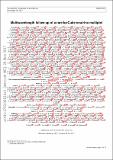Multiwavelength follow-up of a rare IceCube neutrino multiplet
Author(s)
IceCube Collaboration; ASAS-SN; The Astrophysical Multimessenger Observatory Network; Fermi; HAWC Collaboration; LCO; MASTER; Swift; VERITAS; Arguelles Delgado, Carlos A; Axani, Spencer Nicholas; Collin, G. H.; Conrad, Janet Marie; Jones, B.J.P.; Moulai, Marjon H.; ... Show more Show less
Download1702.06131.pdf (2.518Mb)
Terms of use
Metadata
Show full item recordAbstract
© ESO, 2017. On February 17, 2016, the IceCube real-time neutrino search identified, for the first time, three muon neutrino candidates arriving within 100 s of one another, consistent with coming from the same point in the sky. Such a triplet is expected once every 13.7 years as a random coincidence of background events. However, considering the lifetime of the follow-up program the probability of detecting at least one triplet from atmospheric background is 32%. Follow-up observatories were notified in order to search for an electromagnetic counterpart. Observations were obtained by Swift's X-ray telescope, by ASAS-SN, LCO and MASTER at optical wavelengths, and by VERITAS in the very-high-energy gamma-ray regime. Moreover, the Swift BAT serendipitously observed the location 100 s after the first neutrino was detected, and data from the Fermi LAT and HAWC observatory were analyzed. We present details of the neutrino triplet and the follow-up observations. No likely electromagnetic counterpart was detected, and we discuss the implications of these constraints on candidate neutrino sources such as gamma-ray bursts, core-collapse supernovae and active galactic nucleus flares. This study illustrates the potential of and challenges for future follow-up campaigns.
Date issued
2017-11Department
Massachusetts Institute of Technology. Department of Physics; Massachusetts Institute of Technology. Laboratory for Nuclear ScienceJournal
Astronomy & Astrophysics
Publisher
EDP Sciences
ISSN
0004-6361
1432-0746
Collections
The following license files are associated with this item: